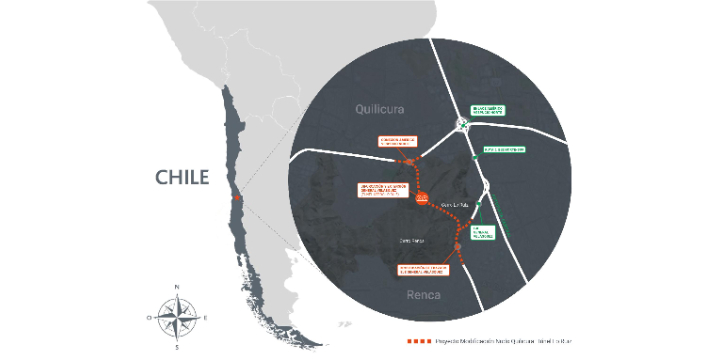Abertis to improve Santiago de Chile’s mobility by building two tunnels in the north of the city

•VíasChile, a Chile-based Abertis subsidiary, and the Chilean Ministry of Public Works have agreed to build two tunnels under Cerro Lo Ruiz to cut the traffic flow in one of the most congested areas of the city of Santiago de Chile by 25%.
•The project envisages building a total of 5.8 km, including two tunnels each measuring 1.5 km long with two lanes in each direction, connecting two key connections for the capital's mobility: the General Velásquez motorway of the Autopista Central with the Autopista Vespucio Norte.
•The project construction tender will be launched in 2024 and work is set to kick off in the first half of 2025. The building will take 50 months and will be compensated with a 25-month contract extension to the Autopista Central concession, thus complying with Abertis' growth strategy.
10 September 2024.- Abertis, the world's leading infrastructure management group, operating through Sociedad Concesionaria Autopista Central S.A., part of the VíasChile group, has been commissioned to develop the Modificación Nudo Quilicura: Túnel Lo Ruiz project, which directly affects the municipalities of Renca and Quilicura, to the north of the capital, Santiago.
The project, which aims to cut traffic flow by 25% and journey times by up to 20 minutes, will involve building 5.8 kms of road, with two tunnels 1.5 km long each and two lanes in each direction, with high safety standards, as well as branches to the General Velásquez Axis of the Autopista Central with the Autopista Vespucio Norte in either direction, both of which are key Santiago mobility connections already managed by VíasChile.
Approximately 370 million euros is to be invested in this road project, creating 620 jobs. The project construction tender is set to be launched in 2024 to ensure that the works kick off in the first half of 2025. The construction work will take 50 months and will be compensated with a 25-month extension to the Autopista Central concession contract, thus complying with Abertis' growth strategy of further investing in assets in return for concession contracts being extended.
The project envisages landscaping of green areas and footpaths, together with recreational concourses, viewpoints, picnic areas and football pitches. Last but not least, and in line with the commitment entered into with the local community during the project's public participation process, vehicle traffic noise will be reduced by covering the road with a structure that will also help to afford the buildings near the viaduct more privacy. Furthermore, an emissions offsetting plan will be implemented during the construction phase.
Autopista Central
The VíasChile-controlled Sociedad Concesionaria Autopista Central operates and supervises maintenance of one of the Metropolitan Region’s main arterial roads, which crosses Santiago from north to south through the Ruta 5 and General Velásquez motorways, which together total 60.5 kilometres.
The concession began operating in 2004, making it the Metropolitan Region’s first urban motorway concession. Autopista Central is divided into a 39.5 kilometre-long north-south section that connects 15 districts of the capital, from the north bank of the Maipo River in the south to the Américo Vespucio ring road in the north, in the Quilicura sector. The second section is the General Velásquez motorway, which runs from Ruta 5 Sur (Las Acacias) in the south to its junction with Ruta 5 Norte and covers a 21 kilometre stretch.
About VíasChile
After more than ten years operating in the country, VíasChile is now renowned as a benchmark motorway operator in the country, and manages 412 kilometres of roads distributed over four concessions in the Metropolitan and Valparaíso regions. The Autopista Central is the country's busiest urban road and the central motorway connecting Santiago. These four will soon be joined by the concession awarded for the Ruta 5 Santiago - Los Vilos, 223 km connecting the Autopista Central with the Autopista Los Andes, the main interurban highway connecting the country’s two strategic regions.
